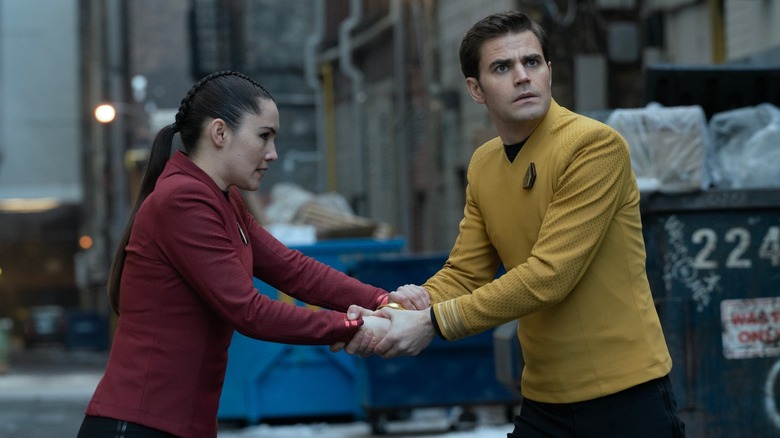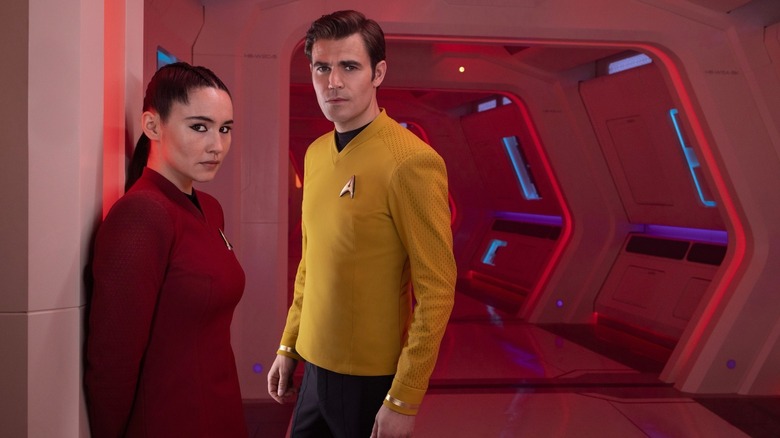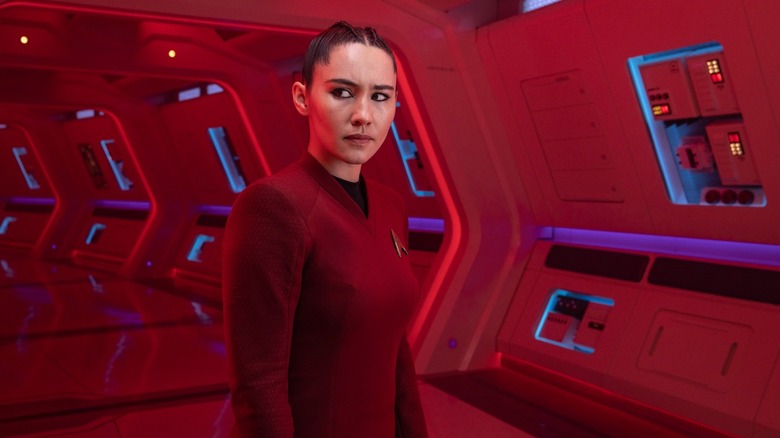Strange New Worlds Season 2's Rules For Time Travel, Explained In Plain English
The third episode of the second season of "Star Trek: Strange New Worlds" is called "Tomorrow and Tomorrow and Tomorrow," and sees Lieutenant La'an Noonien-Singh (Christina Chong) accidentally thrown back in time with an alternate timeline version of James T. Kirk (Paul Wesley). The two arrive in present-day Toronto — but the present-day Toronto from Kirk's alternate timeline — and spend the bulk of the episode trying to find a way to return to their respective futures.
Thanks to several movies and shows in the Marvel Cinematic Universe, a pair of animated Spider-Man movies, and DC's "The Flash," the idea of alternate timelines and parallel doppelgängers is rapidly becoming overexposed and trite. It's no longer surprising or fun to see an alternate version of a character — even a beloved one — appear in a movie or TV show anymore. As a cultural force, the multiverse is barely out of the gate, and it should likely already be retired.
"Star Trek," of course, has long dabbled in alternate timelines, going back at least as far as "Mirror, Mirror" (October 6, 1967), which saw a timeline populated by "evil" versions of the show's main characters. As such, this particular franchise gets a bit of a pass when it comes to multiverse stories. Time travel has come up many, many times in "Star Trek" as well, so Trekkies are well-versed in causality and timeline preservation. Remember when Kirk (William Shatner) traveled back in time to prevent Dr. McCoy (DeForest Kelley) from saving the life of Edith Keeler (Joan Collins)? Because if she lived, the Nazis would take over Earth? Causality, baby.
Indeed, in the lore of "Star Trek," causality is a carefully overseen process, and Starfleet even has authorities to make sure foolhardy officers don't whimsically alter history.
The best of all worlds
Trekkies, on the whole, tend to be analytical people, so when it comes to time travel, many are likely abiding by Ray Bradbury's rules set out in the 1952 short story "A Sound of Thunder." In that story, a time traveler goes to the prehistoric past, steps on a butterfly, and returns to the present to find that small, subtle things about the world have been altered. Even tiny changes in the past can have dramatic effects on the present. This sort of story tends to favor a fatalistic view of life, stemming from a Candide-like assumption that everything in the current timeline is exactly how things ought to be. It's comforting to know that this is the best of all possible worlds.
Starfleet abides by the Bradbury/Candide philosophy as well, trying to prevent time travel if possible, and assuring that the present ends up exactly the way it is now. They fight for the status quo.
In "Tomorrow," La'an encounters an injured time traveler in one of the Enterprise's hallways. He slaps a widget onto La'an's wrist and she vanishes. She appears on a ship that is commanded by Captain Kirk, a status he would not have for several more years in La'an's timeline. While arguing, the two of them activate the widget again and wind up in 21st-century Toronto. They are both immediately aware that they cannot alter history, and have to survive in as discreet a fashion as possible.
Kirk eventually comes to realize that he is from an alternate timeline, and has to accept that he will cease to exist if La'an returns to the world she knew. Kirk, along with the audience, accepts that there is one "legitimate" timeline in "Star Trek." His own can be discarded.
Causality in Star Trek
Because "Star Trek" has always assumed that its own primary canon is the "correct" one, notions of causality are precious. Yes, sometimes Starfleet officers can be cavalier about going back in time and altering history, but as "The City on the Edge of Forever" (the Joan Collins episode mentioned previously) taught us, it's vitally important to stay out of history's way and interact with people as little as possible. (Yes, Mark Twain was once brought on board the Enterprise-D, but he was tactful about his adventures when he returned to his own timeline.) It's the time-travel version of the Prime Directive: Let civilization progress at its own pace, and don't deliberately try to improve or ruin things.
It wasn't until the "Star Trek: Deep Space Nine" episode "Trials and Tribble-ations" (November 4, 1996) that "Trek" introduced an authority on the matter of causality. The Department of Temporal Investigations arrived on DS9 to speak with Captain Sisko (Avery Brooks) about a recent incident that found him about a century in the past, interacting with Captain Kirk. The DTI, of course, was a cute joke, a way of addressing how "Star Trek" is cavalier with time travel shenanigans. In "Star Trek IV: The Voyage Home," for instance, a whaling ship witnessed a full-size Klingon vessel in 1986 San Francisco. A marine biologist was kidnapped and taken to the future. Sometimes it seems, the rules are bent.
It's hilarious, then, that the DTI should refer to Kirk as "a menace." Some people have no respect for causality.
Apart from the franchise's many Mirrior Universe episodes and the "Next Generation" episode "Parallels," multiple timelines aren't a major part of "Trek." Just like on a starship, we like to keep everything tidy.


